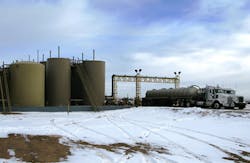New research suggests that the link between seismic activity and oil and gas production activities may vary by region.
Cliff Frohlich, lead author of the study and associate director of the Institute for Geophysics at University of Texas at Austin, has been looking at the relationship between seismicity and industry activity across different geographical areas.
Together with colleagues he analyzed data recorded by the EarthScope USArray, a National Science Foundation-funded network of temporary broadband seismometers, during September 2008 and May 2011, and from IHS, Inc., a company that compiles information about petroleum operations from state regulatory sources.
The authors identified nine regional earthquakes in the Williston Basin, covering an area of approximately 100,000 square kilometers. Three of these nine earthquakes occurred near active injection wells, suggesting a connection to the disposal of wastewater from oil and gas drilling.
Frohlich has previously conducted similar studies, including one of the Barnett Shale near Fort Worth, Texas. In the Barnett Shale region he found significantly greater induced seismicity — 55 earthquakes within a 5,000 square kilometer region.
"Why are earthquakes triggered in some areas and not in others? It's an important question for regulators and the scientific community," said Frohlich. He went on to explain that seismicity might be influenced by differences in geology, orientation of pre-existing faults, local fault strength, injection practices and the timing and duration of oil and gas production.
"Before we implement severe regulations or schemes to manage injection activity in a particular region, we need to do the homework — survey the relationship between seismicity and injection activity there to determine what's warranted," Frohlich concluded.
The results of the study have published in the journal Seismological Research Letters.
